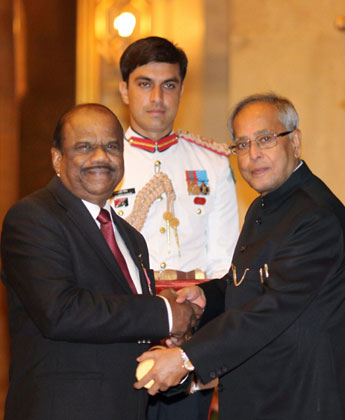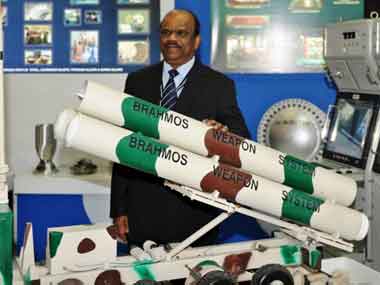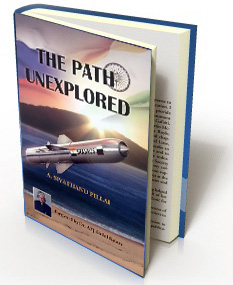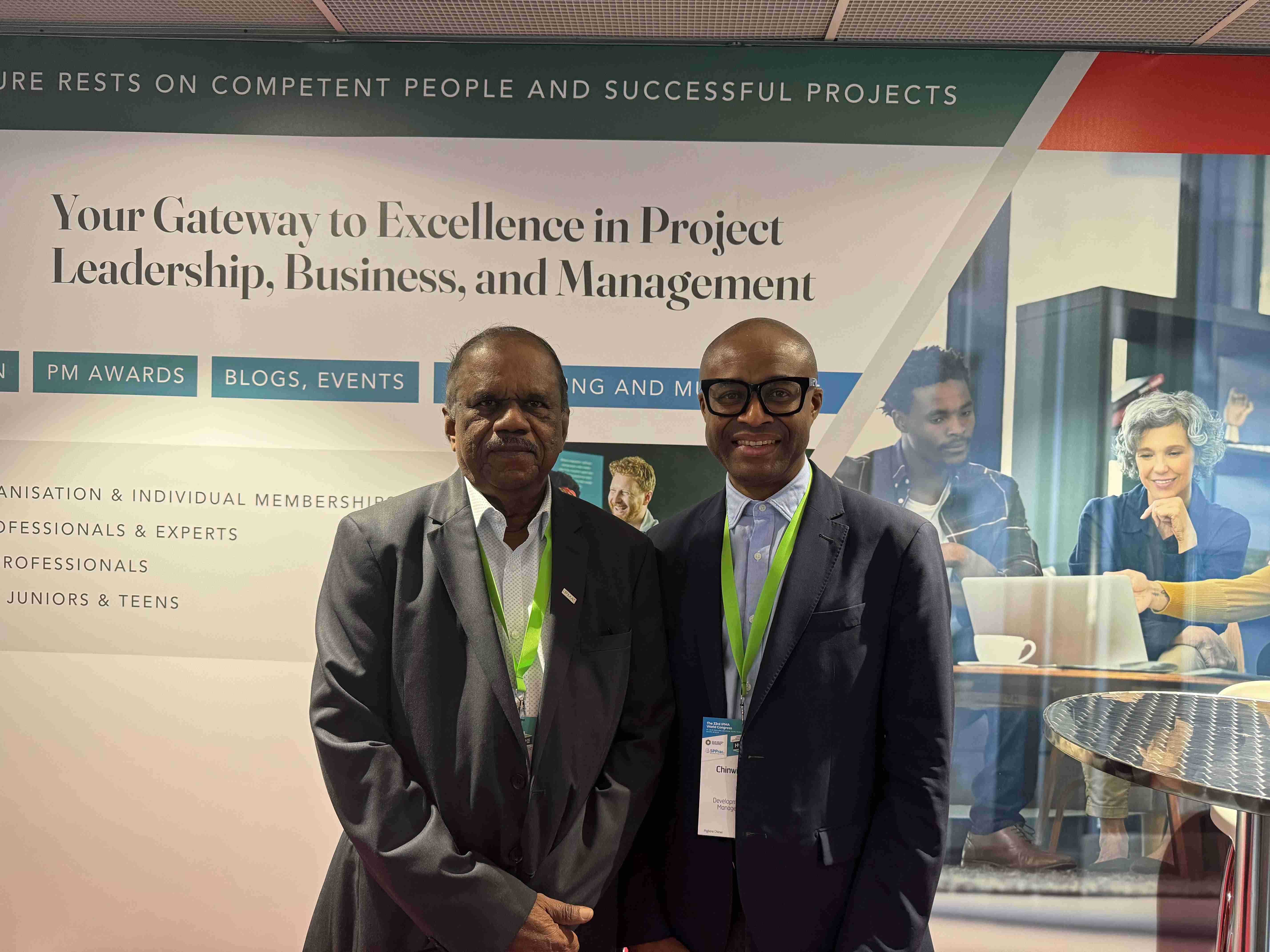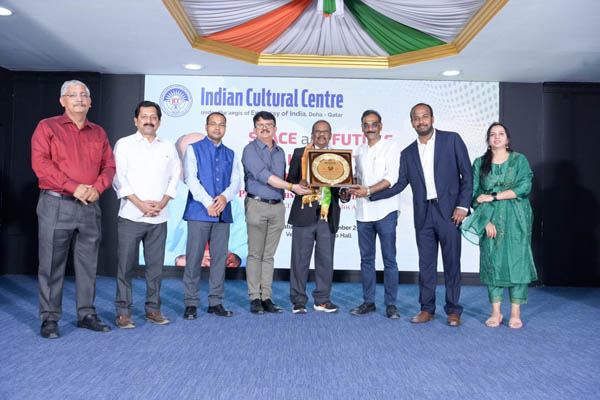Dr. V.C. Kulandaiswamy Endowment Lecture
At College of Engineering, Chennai
13 July 2012 By
Dr. A. Sivathanu Pillai
Distinguished Scientist & Chief Controller R&D, DRDO & CEO&MD, BrahMos Aerospace
"The Nation’s Greatness
– Empowering with Technology"
I am indeed delighted to deliver Dr. V.C. Kulandaiswamy Endowment Lecture at Anna University in honour of his contribution to Technical Education in the country. As Vice Chancellor of this prestigious university for the three consecutive times, Dr. Kulandaiswamy promoted Engineering Education that benefitted largest number of students in acquiring professional acumen for contributing to the development of the nation. Technology is a non-linear tool available to humanity, which can affect fundamental changes in the ground rules of economic competitiveness. Realising this importance of technology in shaping the nation, Dr. Kulandaiswamy initiated several schemes to build technical human resource. His initiative of introducing Distance Education Council and teleconferencing was a unique one that helped many people. Dr. Kulandaiswamy is a great planner and an Institution builder and his initiatives paved way for the creation of many centres of excellence and departments in the niche are of science and engineering. He promoted Institute-Industry Collaboration and encouraged the research programmes. In honour of such a distinguished educationist, technologist, teacher, Tamil scholar, poet and a great personality, I have chosen the topic “The Nation’s Greatness – Empowering with Technology”
India’s Prosperity Dynamics
Ancient scientists of India were far visionary than others, of that time, in all the fields -mathematics, medicine, aviation, astronomy etc. in terms of
scientific achievements. Astronomer & great mathematician – Aryabhatt; Genius in algebra – was the first to proclaim that the earth is round and
rotates on its axis and is acknowledged for calculating ? (Pi) to 3.1416 and Sine table in Trigonometry. Bhaskaracharya was the first to discover gravity,
500 years before Sir Isaac Newton. Acharya Kanad a founder of Atomic theory – said "Every object of creation is made of atoms which in turn connect with
each other to form molecules”; Acharya Susrut; the father of Plastic Surgery performed Rhinoplasty i.e. Restoration of a damaged nose; Acharya Bharadwaj;
pioneered in Aviation Technology, Acharya Kapil gave the concept of cosmology and gave the transformation of energy; to name a few. India was one of the
oldest centres of pre-historic culture of the world and was the cradle of one of the earliest rich and prosperous civilizations in history. The communities
in ancient India were civilized and lived in planned cities with adequate facilities. They built houses of brick, wore cotton clothes and made beautiful
gold and silver jewellery, pottery and toys. The heritage of India is the result of developments in the social, economic, cultural and political life of
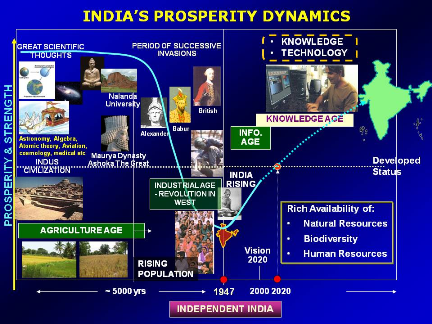 Indians over a period of thousands of years. The Indus Valley civilization and the ruins of Mohenjodaro and Harappa bear testimony to the fact that even as
early as 2500 BC, India had skills to develop agriculture, drainage system, well-planned streets, pottery, tools, jewellery and artefacts. The Harappan
culture was the first urban culture to emerge in India. The rise of cities, crafts and trade also furthered the process of cultural unity. Later, the
Magadh Empire around sixth century BC saw the birth of cities and use of coins. The first society established in the Indus civilisation became a model for
the human race. The prosperity continued during the great Mauryan rule of Chandra Gupta Maurya and later in the third century BC under Emperor Ashoka the
Great when India spread its rule far and wide. He unified almost the entire country under one empire but renounced the use of war as state policy. Instead,
he declared the victory of righteousness as the real victory. In him, we also find a change in the ideal of kingship. India was aptly called the ‘Jewel of
the East’. By the time the ancient period of Indian history came to a close, India had developed a culture which was marked by features that have
characterized it ever since. During the medieval period, some of the achievements of the ancient times were carried forward and new and magnificent
structures were built on those foundations.
Indians over a period of thousands of years. The Indus Valley civilization and the ruins of Mohenjodaro and Harappa bear testimony to the fact that even as
early as 2500 BC, India had skills to develop agriculture, drainage system, well-planned streets, pottery, tools, jewellery and artefacts. The Harappan
culture was the first urban culture to emerge in India. The rise of cities, crafts and trade also furthered the process of cultural unity. Later, the
Magadh Empire around sixth century BC saw the birth of cities and use of coins. The first society established in the Indus civilisation became a model for
the human race. The prosperity continued during the great Mauryan rule of Chandra Gupta Maurya and later in the third century BC under Emperor Ashoka the
Great when India spread its rule far and wide. He unified almost the entire country under one empire but renounced the use of war as state policy. Instead,
he declared the victory of righteousness as the real victory. In him, we also find a change in the ideal of kingship. India was aptly called the ‘Jewel of
the East’. By the time the ancient period of Indian history came to a close, India had developed a culture which was marked by features that have
characterized it ever since. During the medieval period, some of the achievements of the ancient times were carried forward and new and magnificent
structures were built on those foundations.
The metallurgical works of the dancing girl of Mohenjodaro, the earliest known Indian lost-wax process cast bronze figure (third millennium B.C.), the panchloka (five metals) idol of Lord Nataraja (eighth century A.D.) using investment casting process, the rustless 7 m iron pillar of Mauryan dynasty were evidence of a high degree of technical excellence in shaping metals and alloys as a single system. It is a testimony to the skill of ancient Indian blacksmiths. The Grand Anaicut built by the Chola king Karikalan around the second century is an ancient dam built on the KaveriRiver in Tiruchirapalli in the state of Tamil Nadu and is even today is an engineering marvel. Ancient Indians excelled in medicinal and martial arts also. Bodhi Dharma, the third son of Pallava King of Kancheepuram in South India during fifth century went all the way to China to help the people with his knowledge of herbal medicines for curing unknown dreaded diseases and with his knowledge of martial arts protected them. He taught martial arts to the Chinese through his teachings and established the famous Shaolin temple. Nalanda was the first university to attract scholars from more than thirty countries to spread the knowledge. Spread of the Indian kingdoms to the south east countries by the Chola kings Raja Raja and Rajendra enhanced the cultural spread to those countries.
Recent times before independence, the Indian scientists proved themselves equal to those from the West. Sir CV Raman, Ramanujam, Chandrasekar Subramaniam, JC Bose, SN Bose, Meghnad Saha proved Indians are second to none in scientific discoveries. The world has acknowledged them. The most recent finding of Higgs-Boson, so called “God Particle” in the world’s largest high energy particle accelerator, Large Hadron Collider at CERN is a great tribute for the Indian scientists.
Such was the great contribution of India to arts, culture, religious thoughts, science including mathematics, astronomy, cosmology, atomic theory, medicine, yoga and technology including metallurgy, aviation, architecture, township, and also civilisation, spreading to the world.
Alas, nearly one thousand years, India’s value system and wealth eroded due to continuous invasions by several kings and countries. Along with increased population and non-participation in the industrial revolution, the country slipped down on the economic scale. In the 20th century, Industrial revolution took place in the West and India could not able to take part in this revolution, as India was under the rule of the British, and could not get the benefit of industrialisation. Now, during the information age is India is regaining its prideness and in the knowledge age, because of the increased knowledge resources, India’s economic prosperity growth and Indians occupying higher level of knowledge position in the world, India will definitely attain the developed status.
Hurdles in the path of development
Industries in the developed countries are constantly bringing out high technology systems to have competitive edge in performance and market share. The developed countries keep the best technology products with them and offer second rated technology systems to developing countries to ensure maintaining the gap. In order to meet the immediate requirements, the developing countries drain their resources to procure moderate technology systems. Moreover, the developed countries introduced control regimes, technology denials and sanctions to prevent the developing countries to develop new technology products and compete with them. Having lost the valuable resources to import the systems, and technology not being available, the developing countries lose their initiatives in high-tech research. This leads to migration of the best human resources to the industrially advanced countries to develop new technology and systems for them, since that give them opportunities to work in high technology areas and also better living. While the developed countries take full advantage of the talented human resources from the developing countries, they deny the technologies developed by these scientists to the developing countries. It means that the developed countries will have always the technology edge, higher industrial production and large market share and thereby economic growth all the time to come. The developing countries lose their human resources, industrial production and resources, and still continue to be economically backward. This is a major challenge and hurdle for India to become a developed country.
Need of the Hour
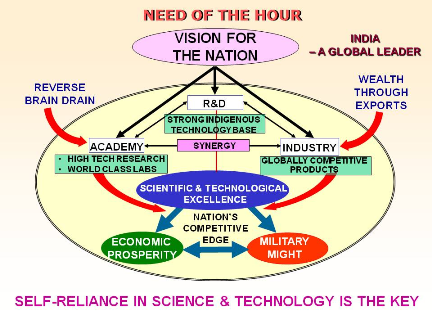 In order to face these challenges, the need of the hour is to have a strong vision for development. There is need to integrate R&D institutions,
academy and industries to give the necessary scientific and technological strength to the nation. This will synergy among three and can bring scientific
and technological excellence. The partnership of academic institutions with R&D organizations will give more opportunities for higher learning and high
technology research leading to reversing the brain drain. Partnership of industry with academy and R&D labs will lead to improved productivity and
growth leading to export of high technology products and generate wealth. Therefore self-reliance in science and technology is the key for achieving the
overall development of the nation. Scientific and Technological excellence alone can make the nation economically strong and militarily secured. Therefore,
the scientists, engineers, technologists and technicians of the country have the responsibility to integrate their efforts into development missions. The
policy makers must help in this process of transforming the vision into reality.
In order to face these challenges, the need of the hour is to have a strong vision for development. There is need to integrate R&D institutions,
academy and industries to give the necessary scientific and technological strength to the nation. This will synergy among three and can bring scientific
and technological excellence. The partnership of academic institutions with R&D organizations will give more opportunities for higher learning and high
technology research leading to reversing the brain drain. Partnership of industry with academy and R&D labs will lead to improved productivity and
growth leading to export of high technology products and generate wealth. Therefore self-reliance in science and technology is the key for achieving the
overall development of the nation. Scientific and Technological excellence alone can make the nation economically strong and militarily secured. Therefore,
the scientists, engineers, technologists and technicians of the country have the responsibility to integrate their efforts into development missions. The
policy makers must help in this process of transforming the vision into reality.
High Technology in India
During the last five decades since independence, India has made all-round technological progress with many accomplishments. The Green Revolution and the Operation Flood have made the country self sufficient in food and the largest producer of milk respectively and are examples of mission mode programmes under the great personalities. India is top ten in the telecommunication network with 943.5 million connections. Advancement in healthcare technologies related to have resulted in increase of life expectancy. The quest for tapping natural resources for power generation has given new impetus to the power sector. The nuclear tests in 1974 and in 1998 made India a nuclear weapon state, and India has mastered harnessing this nuclear energy into power generation to meet the growing demand for electricity, with an aim of reaching 40000 MW power generations by 2020. With established strength in computing systems, software and communication and a large pool of talented software specialists, India has emerged a strong nation in the field of information technology. Spectacular achievements came in space missions, strategic and cruise missiles (Agni, Prithvi and BRAHMOS), aeronautic systems like LCA now called Tejas, IJT, ALH and related aerospace technologies. In 2020, India aims to have new aerospace ventures including moon mission, hyperplane and reusable hypersonic missiles.
Mission Mode Programme
All these could become possible with the great visionary leaders through mission mode programmes.
Agriculture
From a situation of famine and heavy shortage of food in our country, Green Revolution was born in the early 70s by Shri C. Subramaniam, the then Union Minister for Food and Agriculture and supported by Agricultural scientists Dr. M.S. Swaminathan and Nobel Laureate Dr. Norman Borlaugh, using skills in genetic engineering to establish self-sufficiency in food grain production with political will. The success of the Green Revolution can be estimated by the fact that India today grows more than 237 MT of food grain in a year and has the second Green Revolution in place for stepping up to 400 MT in 2020.
Milk
The Dairy Technology has been successful in India with the “White Revolution” conceived by the National Dairy Development Board based at Anand. This was started with the initiative of Dr. Varghese Kurien and inauguration of Kaira District Co-operative Milk Producers Ltd., Anand in Oct. 1955. It started with 64 societies and 20,000 members. Their brand name ‘Amul’ became a household name. Today, India is the largest producer of milk in the world with 100 million tonnes, through cooperative movement.
Steel Industry
The great industrialist of our country Jamshetji Nusswerwanji Tata envisioned India to manufacture steel. When he wanted to establish a steel industry he needed technology of steel making. So he boarded on a ship and went to London to meet his English friends asking for the technology. He met Swami Vivekananda in the same ship. Swami Vivekananda was traveling to Chicago to give the famous address on Hinduism. JN Tata explained Swamiji about his intention. Swamiji told him “When you are trying to make a steel industry, think of building an institution which will teach material science”. JN Tata agreed to the suggestion and got down at London to meet his friends, whom he expected the help, told that if, India makes steel we will eat them. Offended by their statement and refusal of steel technology, he then proceeded to USA to meet some friends, who helped him later. At that point JN Tata remembered Swamiji’s word and established the Indian Institute of Science at Bangalore with a focus on metallurgy and material science. The Indian Institute of Science opened in 1911 in Bangalore, many years after his death. His vision was fulfilled. Visionary may die, but the vision never dies. Today, the Tata family has purchased the steel industry CORUS from the same UK, which refused technology.
Nuclear
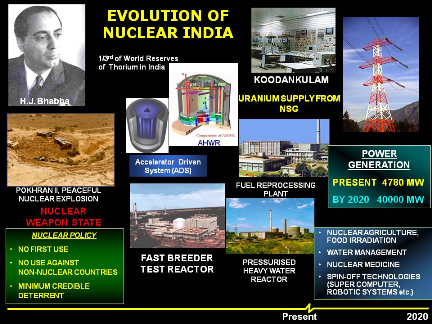 Dr. HJ Bhabha built TIFR and BARC to undertake research in nuclear energy to make the nation strong and to develop and utilize for applications such as for
power generation, food eradication, water management and medicine. The present capacity for power generation is about 4780 MW. As raw material availability
is being ensured, it is time that India has a vision for nuclear energy by realizing 40,000 MW of power by 2020. This will provide an opportunity for
future industrial growth and better quality of life and more agricultural productivity.
Dr. HJ Bhabha built TIFR and BARC to undertake research in nuclear energy to make the nation strong and to develop and utilize for applications such as for
power generation, food eradication, water management and medicine. The present capacity for power generation is about 4780 MW. As raw material availability
is being ensured, it is time that India has a vision for nuclear energy by realizing 40,000 MW of power by 2020. This will provide an opportunity for
future industrial growth and better quality of life and more agricultural productivity.
Space
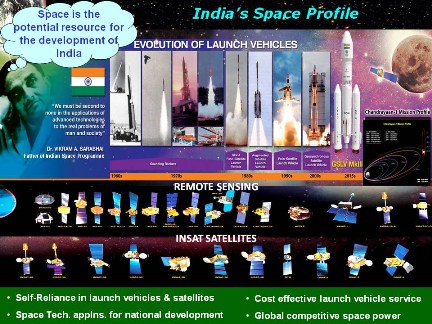 Dr. Vikram Sarabhai pioneered the India’s Space Programme. Dr. Bhabha supported Dr. Sarabhai in setting up the first rocket launching station at Thumba,
primarily because of its proximity to the equator. This development furthered the indigenous capability for satellite launching from low-orbiting to
synchronous levels. The successful launches of PSLV established capacity to lift 1200kg of satellites to an 800km polar orbit. Further developments led to
the launch of GSLV (Geosynchronous Satellite Launch Vehicle) for putting a payload capacity of 2500 kg class satellites in geosynchronous transfer orbit.
The Indian Remote Sensing (IRS) series of satellites have greatly helped in remote sensing including ocean resources survey and high-resolution mapping.
With PSLV & GSLV operational, India has established not only self reliance with launch and satellite capability but also offering cost effective launch
service to different countries. The recent launch of PSLV with ten payloads becomes a milestone in the history of Indian Space. The recent successful
launch of PSLV and the Indian satellite CHANDRAYAAN-I orbiting around the moon shows our mastering in space technology. A new era has begun. Space
Technology has changed the life of a common man. Our satellite based communication and remote sensing technologies have provided services related
education, healthcare, weather, land and water resources management, mitigation of impact of natural disasters, etc. Today we have space based services
such as tele-education including EDUSAT for educational institutions with 74 networks and 55050 classrooms; telemedicine to connect 60 super speciality
hospitals and 16 mobile clinics with 306 hospitals in remote villages, weather prediction and disaster warning systems. The moon mission will help in
exploring the helium-3, the new source of energy, available in abundance at moon.
Dr. Vikram Sarabhai pioneered the India’s Space Programme. Dr. Bhabha supported Dr. Sarabhai in setting up the first rocket launching station at Thumba,
primarily because of its proximity to the equator. This development furthered the indigenous capability for satellite launching from low-orbiting to
synchronous levels. The successful launches of PSLV established capacity to lift 1200kg of satellites to an 800km polar orbit. Further developments led to
the launch of GSLV (Geosynchronous Satellite Launch Vehicle) for putting a payload capacity of 2500 kg class satellites in geosynchronous transfer orbit.
The Indian Remote Sensing (IRS) series of satellites have greatly helped in remote sensing including ocean resources survey and high-resolution mapping.
With PSLV & GSLV operational, India has established not only self reliance with launch and satellite capability but also offering cost effective launch
service to different countries. The recent launch of PSLV with ten payloads becomes a milestone in the history of Indian Space. The recent successful
launch of PSLV and the Indian satellite CHANDRAYAAN-I orbiting around the moon shows our mastering in space technology. A new era has begun. Space
Technology has changed the life of a common man. Our satellite based communication and remote sensing technologies have provided services related
education, healthcare, weather, land and water resources management, mitigation of impact of natural disasters, etc. Today we have space based services
such as tele-education including EDUSAT for educational institutions with 74 networks and 55050 classrooms; telemedicine to connect 60 super speciality
hospitals and 16 mobile clinics with 306 hospitals in remote villages, weather prediction and disaster warning systems. The moon mission will help in
exploring the helium-3, the new source of energy, available in abundance at moon.
Evolution of War Weaponry
The first ‘ballistic weapons’ probably were rocks that caveman hurled at each other. These ‘missiles’ were followed by sticks fitted with pointed stone heads to make spears and later by wood and ‘string’ devices that propelled smaller wooden shafts through the air. In the 18th century, an interesting innovation happened in India in using, first time, a war rocket. Tipu Sultan used the world’s first war rocket in the Srirangapatna war in 1792, launched in huge numbers against the British cavalry. Tipu’s rockets of that period were much more advanced than any known weapon used in the war. The rocket consisted of a tube of 60 mm dia and 250 mm long with 2 kg gun powder, fastened to a sword which can reach to a range of 1.0 to 1.5 km. The metal cylinder used was made of hammered soft iron. The use of iron increased bursting pressure which permitted the propellant to be packed to greater densities thus giving the rocket a higher thrust and range. The rocket is now displayed at WoolwichArtilleryMuseum in London. Moreover, Tipu had trained rocketeers as a special force.
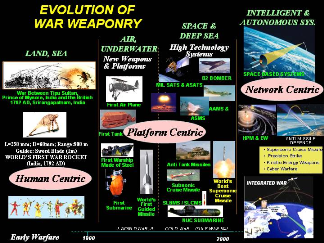
War weaponry had gone through various phases of development, particularly during 20th century with new weapons and platforms. The most significant developments were the V2 rocket – the first guided missile developed by the Germans in the Second World War and Tomahawk cruise missile of USA used in the Gulf war. In the 21st century, BrahMos, a missile which is versatile and capable of multi-role, multi-target and multiple missions, has emerged. From the world’s first rocket in 1792, India travelled to come again in 2001 with BRAHMOS, the world leader of cruise missile family. From human warfare, we have come a long way to intelligent and autonomous systems with faster operations capable to utilise deep sea and space networked with sensors and weapons.
India’s missile programme, IGMDP was led by Dr. APJ Abdul Kalam with his vision of making India a strong & self-reliant country. Today Prithvi and Agni are operational as strategic missile systems.
Agni & Supercomputer
India’s long range guided missile is Agni, the Intermediate Range Ballistic Missile. In its trajectory, it flies to an altitude of 600 kms and flies back to the target point, re-entering the earth’s atmosphere. Re-entry is a very important technology, as the re-entry module has to withstand 3000°C at the point of crossing the atmosphere. Choice of material, shape of the re-entry module, guidance and control algorithm, capability for electronics systems to withstand the high speed and the temperature conditions are the important aspects during re-entry. The technique use for designing the shape of the module was Computational Fluid Dynamics with elaborate software codes to analyze more than 100,000 grid points in the structure. Supercomputer can do the iteration using a fast algorithm, without which, it will take considerable time for the analysis. A two pronged approach was initiated with a group of young scientists to evolve new CFD codes and another group of young scientists to develop a supercomputer. Within 24 months the team came out with a solution to reduce each iteration time from 9 days to 5 minutes, using the fastest Supercomputer PACE++ parallel processor, which was 20 times faster than the Cray XMP Computer, refused to India. The CFD effort resulted a top class CFD centre in the campus of Indian Institute of Science. Networking of Academy and R&D Labs and using fresh young minds from the Universities have tremendously helped to overcome the Technology denial regime instituted by few developed Nations. India proved its might with innovative young minds.
BrahMos Supersonic Cruise Missile – The Brahmastra
The Gulf Wars from 1991 gave us the message that cruise missiles are very important to destroy the enemies’ assets on the first day, without even the enemy knowing. Cruise missiles are stealthy, fly at very low altitude and very precise to hit the target. American Tomahawk missiles were dominant during the Gulf Wars, but it has a subsonic speed. India decided to go for cruise missile development, with a difference. When the whole world was using subsonic (i.e. speed less than that of sound) cruise missiles, India decided to go for supersonic cruise missile, 3 times faster than the sound. To cut short the time of development and inherit very high level of technology, India joined hands with Russia making the BrahMos joint venture. BrahMos is responsible to design, develop, produce and market a world class cruise missile. A new generation young scientists from the Indian institutions with the help of experienced Russian specialists, formed a consortium with industries of India and Russia, made it possible to create a wonderful product, i.e. BRAHMOS. It is a supersonic cruise missile, which can be launched from any platform on land, on sea, underwater and in air with multiple missions against land and sea targets. The unique nature of BrahMos with its universality made Indian Armed Forces, the first in the world to possess supersonic cruise missiles. Various versions of BRAHMOS have been developed, produced and inducted in the Indian Armed Forces on ships and on land. BRAHMOS is the world leader in the cruise missile family. The developed world got astonished to see the Indian might through this Brahmastra. We together established that “ We can do it”.
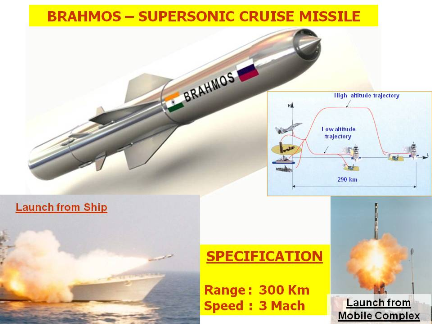
Hypersonic Reusable Cruise Missile–The Sudharshan Chakra
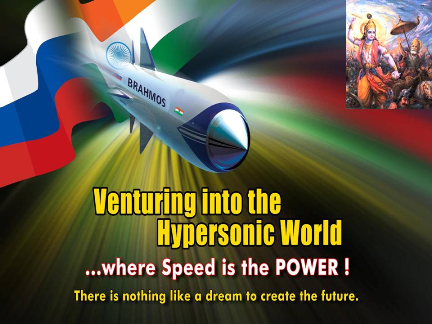 Lord Krishna took Viswaroop at Kurukshetra, with his mighty ever-moving Sudharshan Chakra on his right index finger. The importance of Sudharshan Chakra
was its ever readiness to destroy the enemy and come back. If this is so, the idea came to us that why not we create a hypersonic cruise missile which
destroys the target and flies back to us for re-use. Going at a speed of Mach 7, deliver the warhead, assess the destruction of the target, come back and
get ready to go again, i.e. Hypersonic Reusable Cruise Missile, the next version of Sudharshan Chakra. This is the BrahMos-II programme and it has been
started with its design and basic technology development.
Lord Krishna took Viswaroop at Kurukshetra, with his mighty ever-moving Sudharshan Chakra on his right index finger. The importance of Sudharshan Chakra
was its ever readiness to destroy the enemy and come back. If this is so, the idea came to us that why not we create a hypersonic cruise missile which
destroys the target and flies back to us for re-use. Going at a speed of Mach 7, deliver the warhead, assess the destruction of the target, come back and
get ready to go again, i.e. Hypersonic Reusable Cruise Missile, the next version of Sudharshan Chakra. This is the BrahMos-II programme and it has been
started with its design and basic technology development.
Technology through Ages
During the last 5000 years, unique cultures have come into existence as the man continuously attempted to have better life for himself and the society around him. Technology, over the years, played a very dominant role right from the Stone Age to the industrial revolution and information & knowledge age of today, with different manifestations. We are, today, at the convergence of information with bio and nanotechnologies and the future belongs to the nanotechnology age.
Nanotechnology and its importance
Nano technology is a creation of useful functional materials, devices and systems through control of matter on the nano meter length scale (1-100nm), which is roughly 10000 times smaller than the diameter of a human hair and exploitation of novel phenomenon and properties (physical, chemical, biological, mechanical, electrical etc) at that length scale. The discovery of novel materials, processes, and phenomena at the nanoscale, as well as the development of new experimental and theoretical techniques for research provide fresh opportunities for the development of innovative nanosystems and nanostructured materials. Nanostructured materials can be made with unique nanostructures and properties. This field is expected to open new avenues in science and technology.
Nano technology offers a wide range of possibilities of high efficient and miniaturized systems and devices. Nanotechnology is likely to have a profound impact on our economy and society in the coming years. Research in nanotechnology promises breakthroughs in such areas as materials and manufacturing, nanoelectronics, medicine and healthcare, energy, biotechnology, information technology and defence.
Applications of Nanotechnology
Carbon nanotubes are Carbon nano fibres made in the form of tubular structure and reinforced with polymer matrix will revolutionise future structures which will be lightweight conducting polymers, radar absorbing materials and so on. These structures 100 times stronger than steel while the weight is one sixtieth. These composite structures will have tremendous applications in the future in various high technology fields. Molecular switches and circuits along with nano battery will pave the way for the next generation computers. Ultra dense computer memory coupled with excellent electrical performance will give the society low power, low cost, nano size and yet faster assemblies.
In the area of healthcare, Nano technology will help in diagnostic areas like on the spot detection kits, pathological mapping, body imaging etc. Further nanotechnology would help in the development of systems like artery cleaner for cleaning of blocked arteries leading to prevention of heart attacks, nano neuro transmitters for repair of neurons in the brain, biochips, glucose detection and endoscopic implants and for rectification of defective eye and ear. Drug delivery system will revolutionize the healthcare to a large extent. And many more.
Convergence of Nano-Bio-Info Technologies
 The information technology and communication technology have already converged leading to Information and Communication Technology (ICT). Information
Technology combined with bio-technology has led to bio-informatics. When Nano technology and ICT meet, integrated silicon electronics, photonics are born
and with biotechnology linked, a new science called “Intelligent Bioscience” will be born which would lead to a disease
free, happy and more intelligent human habitat with longevity and high human capabilities. This convergent technology can lead to the development of nano
robots. Nano robots when they are injected into a patient will diagnose and deliver the treatment exclusively in the affected area and then the nano-robot
gets digested as it is a DNA based product.
The information technology and communication technology have already converged leading to Information and Communication Technology (ICT). Information
Technology combined with bio-technology has led to bio-informatics. When Nano technology and ICT meet, integrated silicon electronics, photonics are born
and with biotechnology linked, a new science called “Intelligent Bioscience” will be born which would lead to a disease
free, happy and more intelligent human habitat with longevity and high human capabilities. This convergent technology can lead to the development of nano
robots. Nano robots when they are injected into a patient will diagnose and deliver the treatment exclusively in the affected area and then the nano-robot
gets digested as it is a DNA based product.
Futuristic Nanotechnology Solutions:
World is now facing the problems in energy, water and healthcare. Nanotechnology offers huge promise in overcoming these problems in the future. Let us explore the various possible nanotechnology solutions for these problems.
a) Energy for future generations:
The era of wood and bio-mass is almost nearing its end. The age of oil and natural gas would soon be over even within the next few decades. The world energy forum has predicted that fossil based oil, coal and gas reserves will last for another 5 - 10 decades only. Nuclear, Hydrogen fuel and solar rays are the three modes to get clean power.
CNT based solar cells for higher efficiency
 The solar rays, when passed though presently available solar photovoltaic cells have an efficiency of less than 20%. The low efficiency of conventional
photo voltaic cells has restricted the use of solar cells for large application for power generation. Research has shown that the Gallium Arsenide (GaAs)
based PV cell with multi junction device could give maximum efficiency of 30%. Therefore, the present research trend is on the use of Carbon Nano Tube
(CNT) based PV cell. Both single wall CNTs and multi wall CNTs have been used as electrodes, as electron acceptor, which can split exciton into electrons
and holes to produce electricity.
The solar rays, when passed though presently available solar photovoltaic cells have an efficiency of less than 20%. The low efficiency of conventional
photo voltaic cells has restricted the use of solar cells for large application for power generation. Research has shown that the Gallium Arsenide (GaAs)
based PV cell with multi junction device could give maximum efficiency of 30%. Therefore, the present research trend is on the use of Carbon Nano Tube
(CNT) based PV cell. Both single wall CNTs and multi wall CNTs have been used as electrodes, as electron acceptor, which can split exciton into electrons
and holes to produce electricity.
The CNTs provide better electron ballistic transport property along its axis with high current density capacity on the surface of the solar cell without much loss. Higher electrical conductivity and mechanical strength of CNT could improve the quantum efficiency. Recent research abroad has shown that the alignment of the CNT with the polymer composites substrate is the key issue to give very high efficiency in photovoltaic conversion. The polymer composites increase contact area for better charge transfer and energy conversion. In this process, the researchers could achieve the efficiency of about 50% at the laboratory scale. This will become the cost effective option for generating electric power, particularly in a tropical country like India.
b) Water
More than 70% of earth surface is having water; but only one percent is available as fresh water for drinking purposes. Today, with a global population of 6 billion only 3 billion have access to limited or perhaps the satisfactory supply of water. It is estimated that 33% of the world population has no access to sanitation and 17% has no access to safe water. But by 2025 the world population is going to rise to 8 billion but only one billion will have access to drinking water. Twenty thousand children are affected every day due to polluted drinking water, more than the total mortality due to cancer, AIDS, wars and accidents. There is an urgent need to find solution to safe drinking water availability to our people. Drinking water can be obtained by Reverse Osmosis process from sea water. Singapore has established a large scale RO based water generation plant to solve their drinking water problem. The critical device to give pure water is the filter membrane. This is highly expensive and to be replaced often. Innovation has come now by the use of CNT based membrane filter.
Nano tube filter for water purification
Carbon nanotube filters that efficiently remove micro-to nano-scale contaminants from water and heavy hydrocarbons from petroleum. Made entirely of carbon
nanotubes, the filters are easily manufactured using a novel method for controlling the cylindrical geometry of the structure. The filters are hollow
carbon cylinders several centimeters long and one or two centimeters wide with walls just one-third to one-half a millimeter thick. They are produced by
spraying benzene into a tube-shaped quartz mould and heating the mould to 900°C. The nanotube composition makes the filters strong, reusable, and heat
resistant, and they can be cleaned easily for reuse. The carbon nanotube filters offer a level of precision suitable for different applications. They can
remove 25-nanometer-sized polio viruses from water, as well as larger pathogens, such as E. coli and Staphylococcus aurous bacteria. The researchers
believe this could make
 the filters adaptable to micro fluidics applications that separate chemicals. This is a classic application of Nano science, to age old problem of water
purification. If properly used, this can help in lessoning the burden in our drinking water missions leading to the availability of safe drinking water
that will result in minimizing the water borne diseases.
the filters adaptable to micro fluidics applications that separate chemicals. This is a classic application of Nano science, to age old problem of water
purification. If properly used, this can help in lessoning the burden in our drinking water missions leading to the availability of safe drinking water
that will result in minimizing the water borne diseases.
c) Healthcare
India is a vast country with diverse climatic conditions and a very large population. Due to inadequate healthcare facilities, lack of awareness about hygiene and nutrition, a wide spectrum of diseases occur. The specialist team of TIFAC (Technology Information Forecasting and Assessment Council) in Technology Vision 2020 identified the imperatives for eradication of major diseases - tuberculosis, HIV/AIDS, and waterborne diseases by the next decade and find solutions to cancer, cardiovascular diseases and diabetes. We have to generate cost effective knowledge products in order to cope up with such problems.
Nano Bio medical sensors will play a major role in early detection of dreaded diseases like AIDS. Immuno assays can be used for detecting antigens in blood
samples by introduction of nanoshells attached to anti bodies while sampling blood. Nanomagnetic particles can be used for targeted treatment and
diagnosis. Nanosensor based smart drug delivery systems discharge drug in appropriate quantity and at right time. Similarly, the nanotechnology offer a
wide range of opportunities such as synthetic scaffolding and nanoceramic coatings for tissue repair and implants respectively. Dip
 pen nanolithography is a latest nanofabrication method which uses microscopic tips coated with a material which can be metals, DNA, proteins that is
deposited as ‘ink’ on a wide range of surfaces such as silicon, glass or metal. Nanochips are there to automatically monitor blood sugar levels for
diabetics or the performance of pacemakers or body implants.
pen nanolithography is a latest nanofabrication method which uses microscopic tips coated with a material which can be metals, DNA, proteins that is
deposited as ‘ink’ on a wide range of surfaces such as silicon, glass or metal. Nanochips are there to automatically monitor blood sugar levels for
diabetics or the performance of pacemakers or body implants.
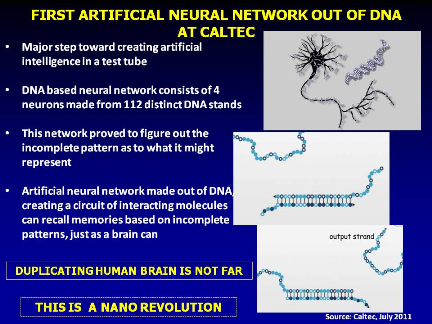 Recently, the Researchers of California Institute of Technology has created the first Artificial Neural Network out of DNA, creating a circuit of
interacting molecules that can recall memories based on incomplete patterns, just as a brain can. The neural network was built of four neurons made up of
112 distinct DNA strands (by contrast, the human brain has some 100 billion neurons). This DNA-based neural network demonstrates the ability to take an
incomplete pattern and figure out what it might represent—one of the brain's unique features. According to the researchers, biochemical systems with
artificial intelligence (or at least some basic, decision-making capabilities) could have powerful applications in medicine, chemistry, and biological
research in answering fundamental biological questions or diagnose a disease. Duplicating of Human Brain is not far with the nano revolution.
Recently, the Researchers of California Institute of Technology has created the first Artificial Neural Network out of DNA, creating a circuit of
interacting molecules that can recall memories based on incomplete patterns, just as a brain can. The neural network was built of four neurons made up of
112 distinct DNA strands (by contrast, the human brain has some 100 billion neurons). This DNA-based neural network demonstrates the ability to take an
incomplete pattern and figure out what it might represent—one of the brain's unique features. According to the researchers, biochemical systems with
artificial intelligence (or at least some basic, decision-making capabilities) could have powerful applications in medicine, chemistry, and biological
research in answering fundamental biological questions or diagnose a disease. Duplicating of Human Brain is not far with the nano revolution.
The recent research in Psychiatry using nanotechnology will revolutionize treatment to mentally challenged persons. The present practice of painful electric shocks for treatment will be eliminated and would be replaced with specific localized electric and magnetic stimulation of the brain parts with minimal pain for the patients.
Futuristic Dominant Technologies
The technologies without any doubt are going to play a major role in the years to come. The futuristic dominant technologies that are going to revolutionise any nation are Nano-Bio-Info Technologies and their Convergence, Robotics and Artificial Intelligence, Advanced Sensors, Smart and Energetic Materials, Green Technologies, Nuclear Fusion Technology, Geo-spatial Technologies, Technologies for Low Cost Access to Space and Mining in Planets and Hypersonic Technologies. The skilled human resources with a hold on futuristic technology will pave way for the competitive product.
India’s Knowledge Potential
 At present India has five hundred and eighty million youth which will continuously be growing till the year 2050. This most valuable resource of our
country needs to be nurtured. In the 21st century, India has plans to empower the talented youth with higher education for the task of knowledge
acquisition, knowledge imparting, knowledge creation and knowledge sharing. Keeping this in mind, our Universities and educational systems will be creating
two cadres of personnel: (1) a global cadre of skilled youth with specific knowledge of special skills (2) another global cadre of youth with higher
education. These two cadres will be utilized not only for powering the manufacturing and services sector of India but also will be made available for
fulfilling the human resource requirements of various countries. All Indian youth will be with either a world class higher education or with world class
skills sets. This will become base for world level required for knowledge based products and systems development.
At present India has five hundred and eighty million youth which will continuously be growing till the year 2050. This most valuable resource of our
country needs to be nurtured. In the 21st century, India has plans to empower the talented youth with higher education for the task of knowledge
acquisition, knowledge imparting, knowledge creation and knowledge sharing. Keeping this in mind, our Universities and educational systems will be creating
two cadres of personnel: (1) a global cadre of skilled youth with specific knowledge of special skills (2) another global cadre of youth with higher
education. These two cadres will be utilized not only for powering the manufacturing and services sector of India but also will be made available for
fulfilling the human resource requirements of various countries. All Indian youth will be with either a world class higher education or with world class
skills sets. This will become base for world level required for knowledge based products and systems development.
India has to aptly exploit its bountiful resources, knowledge base and nurture the growth of advanced technologies to become a developed nation in the next ten years. Technology and knowledge are the two factors which add value to any product. The core strengths will lead to the desired goal through mission projects, the success of which will make India a strong and self-reliant country. India today is in a unique position in the world attracting all developed countries to look at it because India is the best resource hub of young intelligent minds. The history of India dominating during the civilizational age is coming back when the society has moved from agriculture to knowledge. This is a point of greatest advantage for all of us and it provides an opportunity for India to become an economic power and attain Developed India status and will regain its greatness.
At this juncture, I would like to conclude with the saying of the Great Saint, Maharishi Patanchali in his Yoga Sutra:
“When you are inspired by some great purpose, some extraordinary task, all your thoughts break their bounds. Your mind transcends limitations, your consciousness expands in every direction, and you find yourself in a new, great and wonderful world. Dormant forces, faculties and talents come alive, and you discover yourself to be a greater person by far than you ever dreamt yourself to be.”
Thank you




